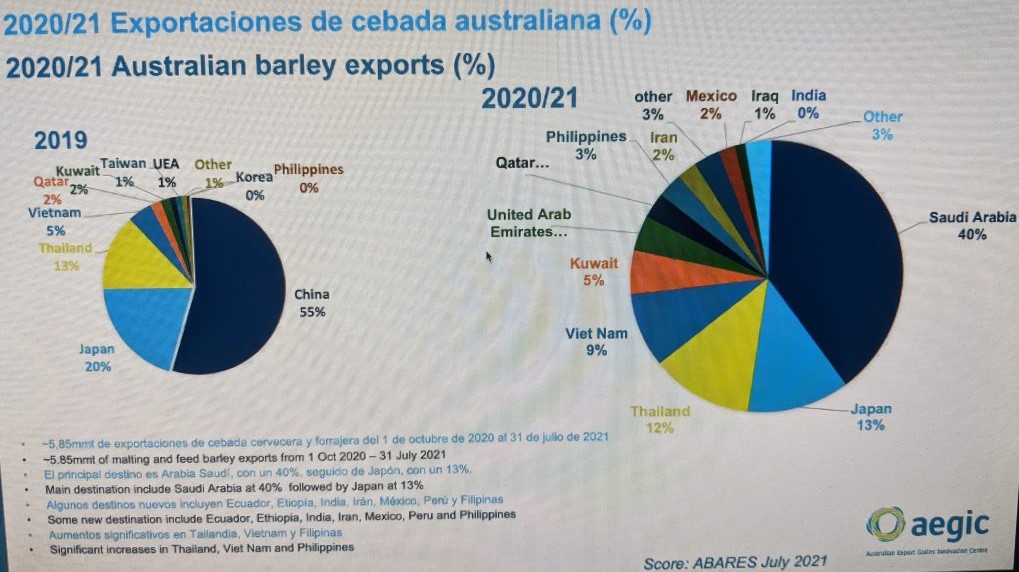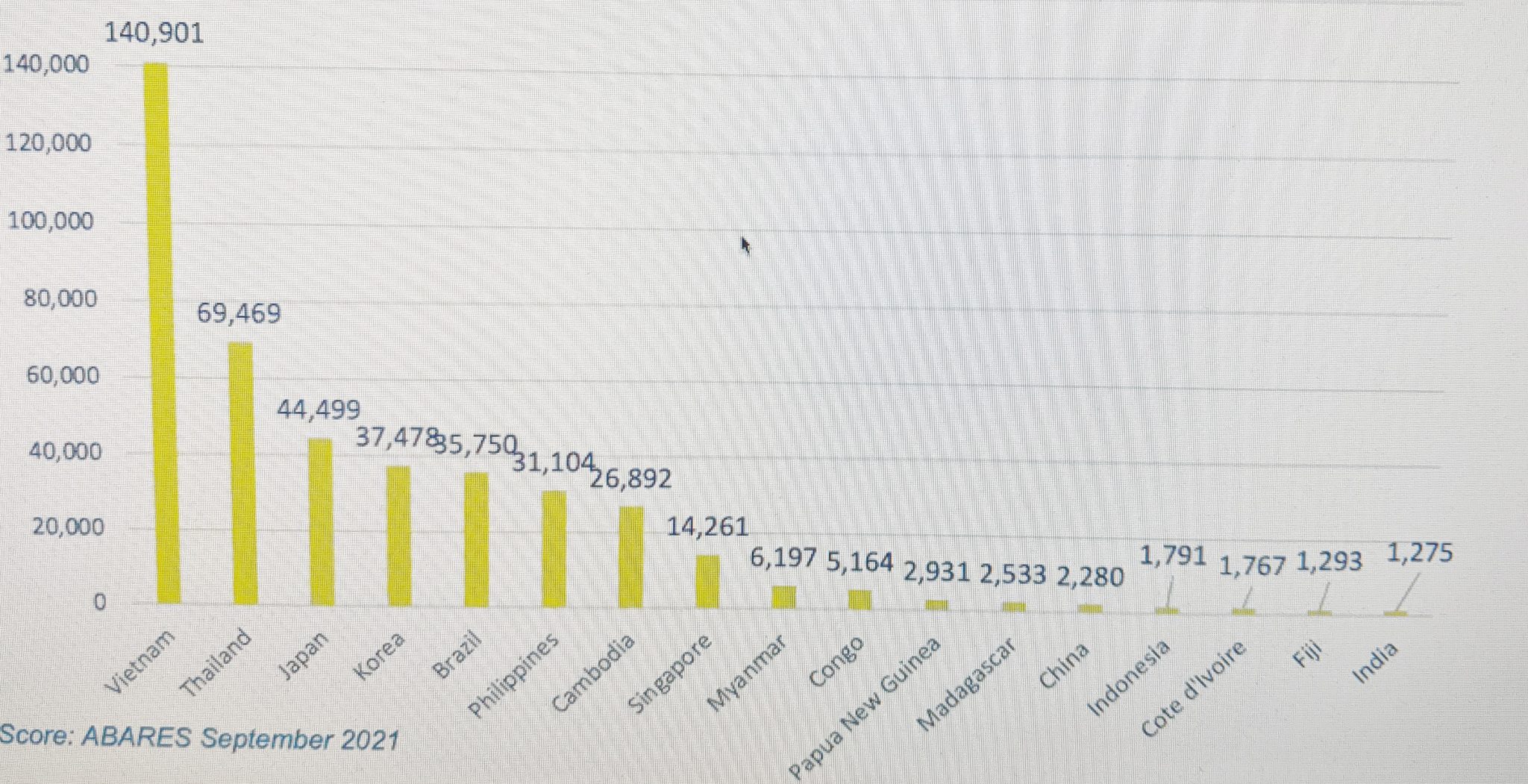Australian barley courts Latin America ahead of harvest

The Australian barley industry is making a concerted effort to sell malting barley parcels, large and small, into Latin America as harvest 2021 ramps up and Australian barley exporters enter their second year with China off the books.
To showcase its merits to the burgeoning market, the Australian Exports Grains Innovation Centre (AEGIC) this morning hosted its first webinar aimed at boosting sales.
Entitled ‘Australian barley: adding value to Mexico and Colombia’s malting and brewing industries’, it delivered a compelling sales pitch.
Low moisture, underpinned by quality assurance, suitable varieties, and reliable supply were played as the trump cards.
Western Australia’s CBH Group in January sent its first cargo of malting barley to Mexico. Up to August 31, Australia shipped around 141,000 tonnes to Mexico.
It puts Mexico on track to be Australia’s biggest malting customer for 2020-21, ahead of Vietnam on around 123,000t over the same eight months.
Other Latin American countries have also provided significant support, with Ecuador importing 12,000t, and Peru 76,000t.

China has disappeared as a market for Australian barley, and feed buyer Saudi Arabia has been Australia’s biggest 2020-21 market. Source: AEGIC
Those tonnages pale when put next to China’s pre-tariff imports of Australian malting barley — around 2 million tonnes (Mt), or roughly half Australia’s malting barley crop — they are hugely significant in the current global market.
It has readjusted to China closing the door to Australia as its major supplier of malting barley, and increasing its imports from origins including Argentina, Canada, France and Ukraine.
Mexico remains the United States’ biggest malting barley market, buying more than 350,000t per year, and the US remains Mexico’s biggest export market for beer.
Mexico malts its own malting barley, and has traditionally imported additional tonnage from Europe and the Black Sea.
It is a growing market, as evidenced by Malteurop’s construction of its first Mexican malting plant, a 120,000t-per-annum facility at Meoqui.
Part of its output will be under a long-term contract with Heineken, which was the destination for malt made from the maiden CBH cargo.
Addressing the AEGIC webinar were Australian Ambassador to Mexico Remo Moretta, Australian Embassy in Mexico agricultural councillor Kate Makin, and Australian Ambassador to Colombia Erika Thompson.
Mr Moretta said the Trans-Pacific Partnership, with Australia and Mexico among the signatories, had widened the doorway to trade.
“The relationship between our countries is growing…so both countries can access markets and diversify their trade,” Mr Moretta said.
While Colombia is yet to appear as an importer of Australian barley, it has a vibrant brewing sector, and Ms Thompson said a reduction of its tariff could be expected as its negotiations within The Pacific Alliance continued.
“We understand there’s a lot of interest here in Colombia to reduce the tariff,” Ms Thompson said.
“We are very interested in the process and we anticipate something at least in the coming year.”
Australian barley production in recent years has seen around 4 million hectares planted to produce roughly 10Mt, making it the country’s second-biggest crop behind wheat.
Australian presenters on the webinar were AEGIC barley markets manager Mary Raynes, Barley Australia (BA) executive chair Dr Megan Sheehy, and Grain Trade Australia chief executive officer Pat O’Shannassy.
Ms Raynes and Mr O’Shannassy drove home the message that Australia was a reliable and high-quality producer, while Dr Sheehy ran through BA’s variety-assessment process which ensures customers get fit-for-purpose product.
Ms Raynes assured those listening that Australia could be relied upon to supply white, bright, plump two-row barley with protein of an ideal 9-12pc.
“We have grain that is dry and is food and feed safe.”
Ms Raynes said varietal purity of 95 per cent — “even greater if on contract” — was also assured.
Of the malting barley planted across Australia this year, Spartacus variety is seen as comprising 37pc of area, RGT Planet 32pc and Compass 15pc.
Australia is on track to produce an above-average 12.5Mt of barley from the harvest now under way in all mainland states bar Victoria.
Around 35pc of the national crop usually can be classified malting, and the bulk of that is exported.
Based on ABARES latest estimates for combined feed and malting barley production, WA is forecast to produce 4.9Mt, South Australia 2.2Mt, Victoria 2.3Mt, New South Wales 2.7Mt and Queensland, rarely an exporter, 377,000t.
Ms Raynes said varieties planted gave an indication from the start of the growing season as to how much malting would be produced.
“Forecasting of barley variety production contributes to informed procurement decisions for commercial businesses.
“No matter what your requirements are, there is an Australian malting barley variety to suit your needs.
“Be assured that you will have consistency of supply.
“If you’re using Spartacus and RGT Planet, that variety will still be available in a few years.”

Australian 2020-21 malting barley exports. Tonnes. Source: AEGIC graphic of ABARES data
Barley Australia’s members include Australia’s major seed companies, maltsters and brewers, and Dr Sheehy said the recent incorporation of Pilot Malting Australia into varietal Stage 1 assessment had been significant.
“Having Pilot Malting Australia involved now in the program design is absolutely critical; it’s been hugely beneficial to the program, and it’s really moved the program to the next level.”
Dr Sheehy said the involvement of maltster members in Stage 2 was also crucial.
“Nothing can replace putting the varieties through their paces in a commercial facility.
“We don’t make an assessment on the market fit: we make an assessment on whether that variety can make malt and make beer.”
Dr Sheehy ran through the numerous varieties under assessment for accreditation for malting, and said this was necessary in order to service different growing regions and market requirements.
“It’s import to have a range of agronomic performance and varieties, and a range of malt quality.
“We feel we are providing options for both the grower and the marketplace.”
Dr Sheehy said craft brewers used no adjunct in their process, but some commercial brewers require high fermentability as they use a large amount of adjunct, and the Australian industry could produce barley to suit both those applications, and ones in between.
GTA chief executive officer Pat O’Shannassy said Colombia had previously been a market for Australian wheat, and had hopes for it becoming a barley customer.
“It’s going to be really good to engage again on that level,” Mr O’Shannassy said.
He said containers typically accounted for around 10-12pc of Australian grain exports, and they might be a good way to get the ball rolling.
“There is a way of building a business out of Australia and…it can start with containers.”
He told the webinar audience that dryness and quality assurance were the hallmarks of Australian malting.
“Lower moisture is one of the advantages we have against international competitors.”
He said “every single truckload” of grain in Australia was sampled and tested once it left the farm.
“Barley is sampled religiously…through that supply chain as well.”
Sailing time for Australian barley to Latin America is considerably longer than to anywhere in Asia, and this holds one advantage.
As Grain Industry Market Access Forum executive manager Tony Russell pointed out, it allows on-board fumigation to take place.
“This certainly provides more flexibility for exporters, and makes it more efficient.”
Ms Raynes said AEGIC intended to hold another webinar involving Latin American in February-March, and incorporate a panel discussion with some of its maltsters and brewers.
“We want you to learn more and gain value.”
Read also
Wheat in Southern Brazil Impacted by Dry Weather and Frosts
Oilseed Industry. Leaders and Strategies in the Times of a Great Change
Black Sea & Danube Region: Oilseed and Vegoil Markets Within Ongoing Transfor...
Serbia. The drought will cause extremely high losses for farmers this year
2023/24 Safrinha Corn in Brazil 91% Harvested
Write to us
Our manager will contact you soon



